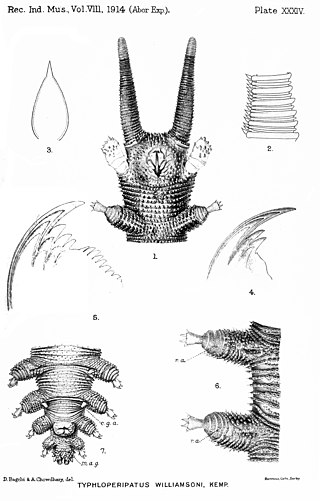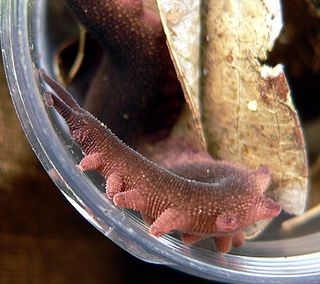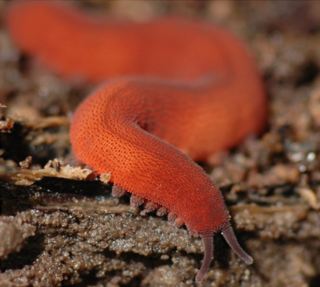
Peripatus is a genus of velvet worms in the Peripatidae family. The name "peripatus" is also used to refer to the Onychophora as a whole, although this group comprises many other genera besides Peripatus. The genus Peripatus is found in Central America, the Caribbean and northern South America. This genus is viviparous, with mothers supplying nourishment to their embryos through a placenta.

Typhloperipatus is a genus of velvet worm in the family Peripatidae, containing the sole species Typhloperipatus williamsoni. This genus is notable for containing the only species in the phylum Onychophora found in South Asia. This species is also striking in that this velvet worm shows no external trace of eyes, although rudimentary optical vesicles are present internally.

Peripatidae is a family of velvet worms. This family includes more than 90 described species distributed among 13 genera, but some authorities deem only 80 of these species to be valid. The oldest putative representatives of the family herald from Burmese amber dated to the mid-Cretaceous, around 100 million years ago, with representatives from Dominican and Baltic amber attesting to a broader distribution in the Palaeogene / Neogene; molecular variability suggests that the family's crown group may have arisen in the early Mesozoic.

Eoperipatus is a genus of velvet worms in the family Peripatidae. These velvet worms have been reported from locations throughout Southeast Asia, including Malaysia, Singapore, Thailand, and Vietnam. This genus exhibits lecithotrophic ovoviviparity; that is, mothers in this genus retain yolky eggs in their uteri.

Epiperipatus is the most diverse genus of neotropical velvet worms in the family Peripatidae. Species in this genus are found in Central and South America. This genus is viviparous, with mothers supplying nourishment to their embryos through a placenta.

Oroperipatus is a genus of Neotropical velvet worms in the family Peripatidae. Species in this genus are found in South America west of the Andes and in Mexico. This genus is viviparous, with mothers supplying nourishment to their embryos through a placenta.
Paraperipatus is a genus of velvet worms in the family Peripatopsidae. This genus exhibits matrotrophic viviparity, that is, mothers in this genus retain eggs in their uteri and supply nourishment to their embryos, but without any placenta. Species in this genus are found in New Guinea and the surrounding islands, including the Maluku achipelago.
Eoperipatus horsti is a species of velvet worm in the Peripatidae family. Authorities have designated this velvet worm as the type species for the genus Eoperipatus, because among the species originally included in this genus, this species is the only one known from descriptions of both sexes. This species is found in Malaysia.
Eoperipatus butleri is a Malaysian species of velvet worm in the Peripatidae family.
Eoperipatus weldoni is a species of velvet worm in the Peripatidae family. This velvet worm is dark brown with pale spots and a darker line running down the middle of its back. The ventral surface is yellowish grey with small spots of brown. This species has 23 to 25 pairs of legs and can reach 65 mm in length, but the average specimen is 58 mm in length. The type locality is in West Malaysia.
Epiperipatus cratensis is a species of velvet worm in the family Peripatidae. This species is found in northeastern Brazil. This velvet worm is notable as a small species of Epiperipatus with many legs.
Epiperipatus hilkae is a species of velvet worm in the Peripatidae family. This species is found in Costa Rica. This velvet worm is closely related to another species of Epiperipatus found in Costa Rica, E. isthmicola. The species E. hilkae is named in honor of the German zoologist Hilke Ruhberg for her extensive work on velvet worms.
Epiperipatus machadoi is a species of velvet worm in the Peripatidae family. This species is dark brown with a series of light brown arcs on each side forming circles down its back and ranges from 20 mm to 66 mm in length. Males of this species have 27 to 29 pairs of legs, usually 28; females have 28 to 31, usually 31. The type locality is in Minas Gerais, Brazil.
Oroperipatus lankesteri is a species of velvet worm in the Peripatidae family. This velvet worm is notable for its large size, reaching 82 mm in length. This species is known only from its type locality in the northern Pacific lowlands of Ecuador.
Oroperipatus peruvianus is a species of velvet worm in the Peripatidae family. Males of this species have 34 pairs of legs; females have 36 or 37 pairs. This velvet worm is found in Peru.
Peripatus dominicae is a species of velvet worm in the Peripatidae family. The type locality for this species is on the Caribbean island of Dominica. Although the Canadian zoologist Stewart Peck introduced the name Peripatus dominicae dominicae in 1975 to distinguish the original species from other subspecies then assigned to P. dominicae, authorities now deem these subspecies to be separate species in light of the significant distances between their type localities.
Mongeperipatus solorzanoi, also known as Solórzano's velvet worm, is a species of velvet worm in the family Peripatidae. This species is the largest known velvet worm, reaching 22 cm in length. This velvet worm is found in the Caribbean coastal forest of Costa Rica.
Mongeperipatus is a genus of velvet worms in the family Peripatidae from Costa Rica. The biologists José Pablo Barquero-González, Steven Sánchez-Vargas, and Bernal Morera-Brenes introduced this genus in 2020 to contain the newly discovered type species, M. kekoldi, together with another species, M. solorzanoi. A phylogenetic analysis using DNA sequences placed these two species in their own monophyletic clade. Furthermore, these two species share morphological characters that indicate that these species do not belong in the other genera and instead belong together in a separate genus. The genus Mongeperipatus is named in honor of the Costa Rican biologist Julián Monge-Nájera.
Epiperipatus hyperbolicus is a species of velvet worm in the family Peripatidae. This velvet worm is known only from its type locality in the state of Alagoas in Brazil. The species name refers to the unusually large apical piece on the primary papillae on this velvet worm. This distinctive apical piece is notable for its size and spherical shape. The males of this species have 23 pairs of legs; females have 24 or 25 pairs.
Epiperipatus titanicus is a species of velvet worm in the family Peripatidae. This velvet worm is known only from its type locality in the state of Alagoas in Brazil. The species name refers to the large size of its females and its numerous legs. This species features more legs than any other Brazilian species of velvet worm.






